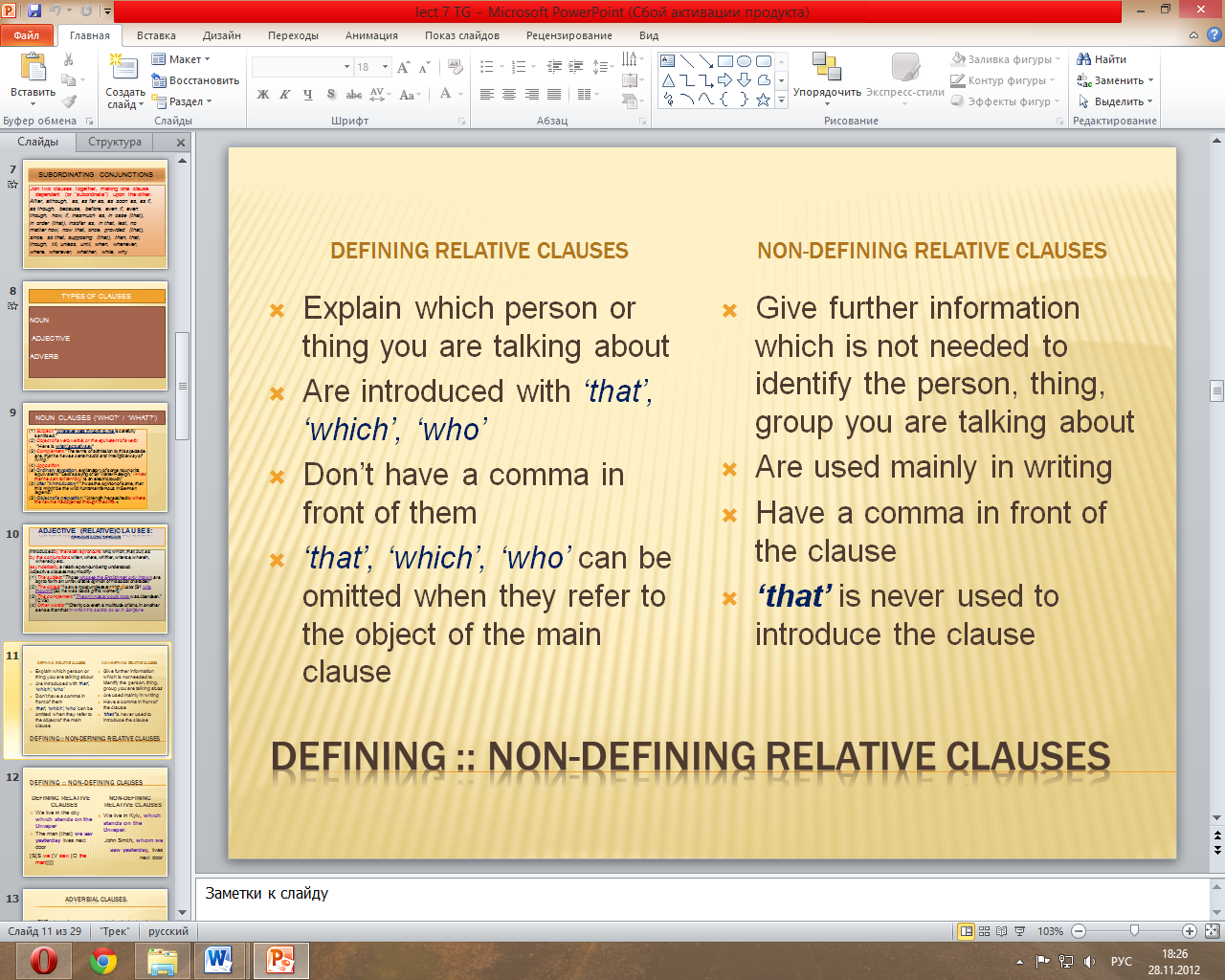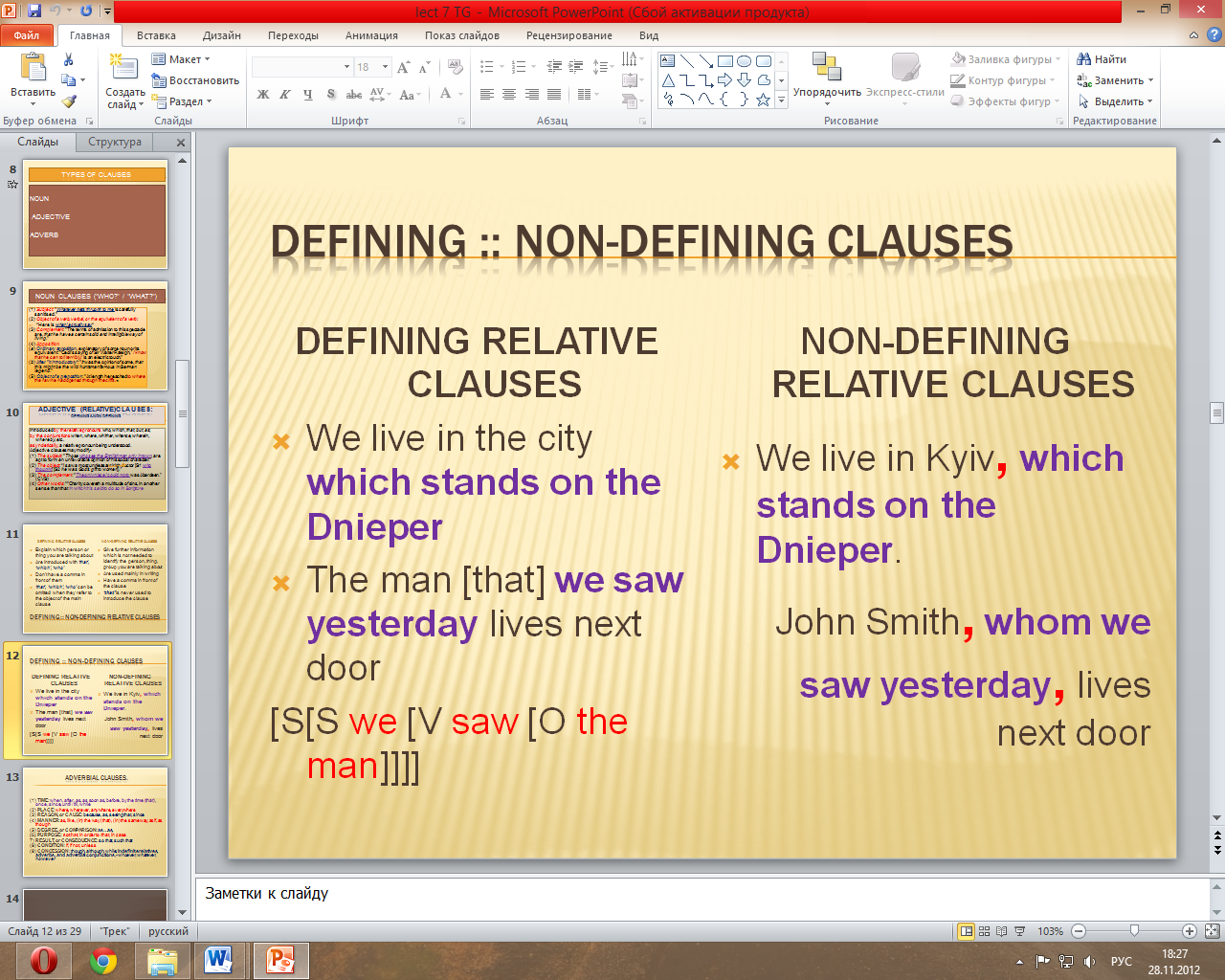
- •3.Semantic types of complex sentences
- •Noun clauses
- •2)Adjective / relative clauses ((non)defining)
- •3) Adverb clauses
- •7) Result, or consequence: so that, such that
- •4.Pragmatics as an approach of speech study
- •John Austin’s “How To Do Things With Words"
- •6)Types of addressee
- •7) Classification of Speech Acts
- •Illocutionary speech acts:
Structural types of sentences
Compound sentences
The second type of sentence is the compound
sentence. This sentence is composed of two simple sentences joined
together by a comma and a joining word (coordinating conjunction). We
could also describe a compound sentence as two independent clauses
joined by a conjunction.There are seven coordinating conjunctions:
And but so or for nor yet.

Complex sentences
A complex sentence has an independent clause joined by one or more dependent clauses. A complex sentence always has a subordinator such as because, since, after, although, or when or a relative pronoun such as that, who, or which.
After I came home, I made dinner.
When a complex sentence begins with a subordinator, a comma is required at the end of the dependent clause.
When the independent clause begins the sentence with subordinators in the middle no comma is required.
3)Compound / complex sentences
A compound-complex sentence is made up of a compound sentence and a complex sentence! I would say these guys are properly named, wouldn't you?
The compound part of the equation means that the sentence has two (or more) independent clauses.
The complex part of the equation means that the sentence has at least one subordinate clause.
2- Coordinating, subordinating connection of sentences
Coordinating conjunctions are used to join independent clauses to make compound sentences. The coordinating conjunctions are as follows: and, but, for, nor, or, so, and yet. You can use coordinating conjunctions to revise run-on sentences and comma splices (see above). You can also use coordinating conjunctions to make writing less choppy by joining short, simple sentences. Consider the following examples.
Independent Clauses: I wanted more popcorn. Sam wanted Junior Mints.
Joined Together: I wanted more popcorn, but Sam wanted Junior Mints.
In this example, it is necessary to put a comma before the coordinating conjunction but because there are two independent clauses being combined. Another way to think of this is that I wanted more popcorn and Sam wanted Junior Mints could stand on their own as independent sentences. So, there must be a comma and a conjunction between them.
Independent Clauses: I wanted more popcorn. I didn’t want any more soda.
Joined Together: I wanted more popcorn but no soda.
In this example, we’ve combined the sentences with the coordinating conjunction but. We’ve also eliminated some of the words so that the sentence wouldn’t sound redundant. In this case, it isn’t necessary to put a comma before but because there are not two independent clauses joined together.
Subordinating conjunctions are used to join independent clauses to make complex sentences. The subordinating conjunctions are as follows: after, although, as, as if, because, before, even if, even though, if, if only, rather than, since, that, though, unless, until, when, where, whereas, wherever, whether, which, and while.
You can use subordinating conjunctions to correct run-on sentences and comma splices. And you can use them to combine sentences so that writing is less choppy. Consider the following examples.
Complex Sentence: I wanted to get more soda because it’s hard to eat popcorn without it.
In this sentence, the subordinate clause is at the end. It would also be correct to place the subordinate clause at the beginning of the sentence:
Because it’s hard to eat popcorn without it, I wanted to get more soda.
Notice that when the subordinate clause comes at the beginning, it’s necessary to insert a comma.
Complex Sentence: While I was getting more soda and popcorn, I missed a really important part of the movie. (Subordinate clause at the beginning of the sentence).
I missed a really important part of the movie while I was getting more soda and popcorn. (Subordinate clause at the end of the sentence).
Asyndetic connection
"asyndetic" (connections made without conjoins).
The coordinate clauses can be combined asyndetically (by the zero coordinator), e.g.: The quarrel was over, the friendship was resumed.
3.Semantic types of complex sentences
Noun clauses
(1) Subject: "Whatever gets thruogh to me is carefully sanitised."
(2) Object of a verb, verbal, or the equivalent of a verb:
“Here is what I actually say.“
(3) Complement: "The terms of admission to this spectacle are, that he have a certain solid and intelligible way of living."
(4) Apposition.
(a) Ordinary apposition, explanatory of some noun or its equivalent: "Cecil's saying of Sir Walter Raleigh, ' I know that he can toil terribly,' is an electric touch."
(b) After "it introductory“: "It was the opinion of some, that this might be the wild huntsman famous in German legend."
(5) Object of a preposition: "At length he reached to where the ravine had opened through the cliffs.«
2)Adjective / relative clauses ((non)defining)
introduced by the relative pronouns who, which, that, but, as;
by the conjunctions when, where, whither, whence, wherein, whereby, etc.
asyndetically, a relative pronoun being understood.
Adjective clauses may modify-
(1) The subject: "Those who see the Englishman only in town, are apt to form an unfavorable opinion of his social character."
(2) The object: “I saw a most unpleasant Irish doctor [S1 who thought] [S2 he was God’s gift to women]]."
(3) The complement: "The only place I could go to was Aberdeen.” (CVS)
(4) Other words: “"Charity covereth a multitude of sins, in another sense than that in which it is said to do so in Scripture


3) Adverb clauses
(1) TIME: when, after, as, as soon as, before, by the time (that), once, since, until / till, while
(2) PLACE: where, wherever, anywhere, everywhere
(3) REASON, or CAUSE: because, as, seeing that, since
(4) MANNER: as, like, (in) the way (that), (in) the same way, as if, as though
(5) DEGREE, or COMPARISON: as…as,
(6) PURPOSE: so that, in order to /that, in case
7) Result, or consequence: so that, such that
(8) CONDITION: if, if not, unless
(9) CONCESSION: though, although, while; indefinite relatives, adverbs, and adverbial conjunctions,- whoever, whatever, however
4.Pragmatics as an approach of speech study
Pragmatics is concerned with bridging the explanatory gap between sentence meaning and speaker's meaning.
Pragmatics is all about use.
to describe pragmatics, one must describe semantics, and to describe semantics one must describe syntax:
syntax semantics pragmatics
Pragmatics is a subfield of linguistics which studies the ways in which context contributes to meaning. Pragmatics encompasses speech act theory, conversational implicature, talk in interaction and other approaches to language behavior in philosophy, sociology, and linguistics and anthropology. Unlike semantics, which examines meaning that is conventional or "coded" in a given language, pragmatics studies how the transmission of meaning depends not only on structural and linguistic knowledge (e.g., grammar, lexicon, etc.) of the speaker and listener, but also on the context of the utterance, any preexisting knowledge about those involved, the inferred intent of the speaker, and other factors
